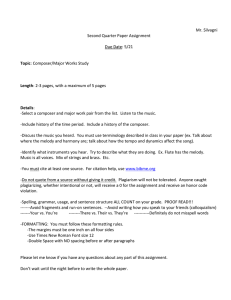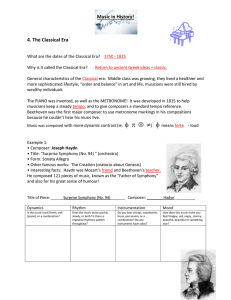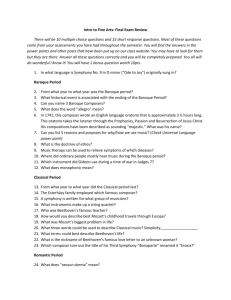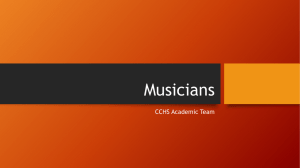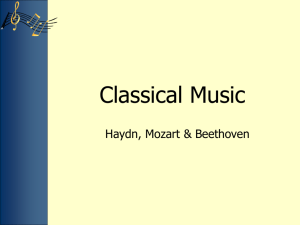Texas Tech University School of Music Study guide
advertisement
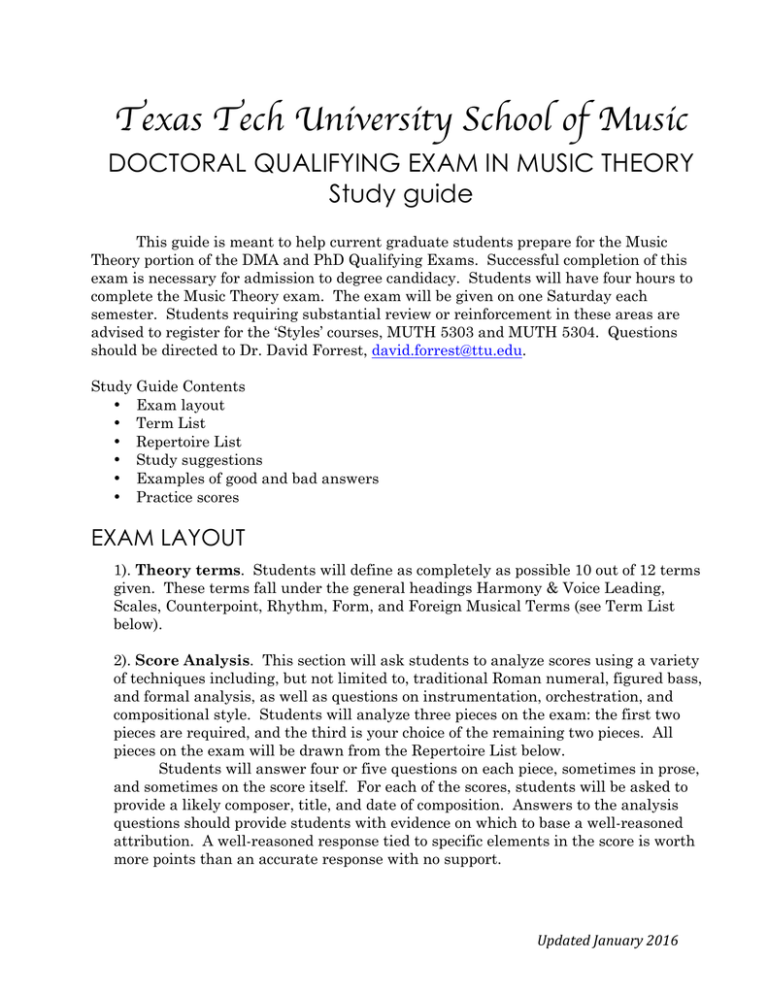
Texas Tech University School of Music DOCTORAL QUALIFYING EXAM IN MUSIC THEORY Study guide This guide is meant to help current graduate students prepare for the Music Theory portion of the DMA and PhD Qualifying Exams. Successful completion of this exam is necessary for admission to degree candidacy. Students will have four hours to complete the Music Theory exam. The exam will be given on one Saturday each semester. Students requiring substantial review or reinforcement in these areas are advised to register for the ‘Styles’ courses, MUTH 5303 and MUTH 5304. Questions should be directed to Dr. David Forrest, david.forrest@ttu.edu. Study Guide Contents • Exam layout • Term List • Repertoire List • Study suggestions • Examples of good and bad answers • Practice scores EXAM LAYOUT 1). Theory terms. Students will define as completely as possible 10 out of 12 terms given. These terms fall under the general headings Harmony & Voice Leading, Scales, Counterpoint, Rhythm, Form, and Foreign Musical Terms (see Term List below). 2). Score Analysis. This section will ask students to analyze scores using a variety of techniques including, but not limited to, traditional Roman numeral, figured bass, and formal analysis, as well as questions on instrumentation, orchestration, and compositional style. Students will analyze three pieces on the exam: the first two pieces are required, and the third is your choice of the remaining two pieces. All pieces on the exam will be drawn from the Repertoire List below. Students will answer four or five questions on each piece, sometimes in prose, and sometimes on the score itself. For each of the scores, students will be asked to provide a likely composer, title, and date of composition. Answers to the analysis questions should provide students with evidence on which to base a well-reasoned attribution. A well-reasoned response tied to specific elements in the score is worth more points than an accurate response with no support. UpdatedJanuary2016 TERM LIST SCALES 1. Ionian 2. Dorian 3. Phrygian 4. Lydian 5. Mixolydian 6. Aeolian 7. Locrian 8. melodic minor scale 9. harmonic minor scale 10. natural minor scale 11. whole-tone scale 12. octatonic scale 13. pentatonic scale HARMONY AND VOICE LEADING 14. tonic 15. dominant 16. subdominant 17. mediant 18. submediant 19. supertonic 20. leading tone 21. subtonic 22. secondary dominant 23. secondary function 24. tonicization 25. modulation 26. modal mixture 27. cadential 6/4 chord 28. passing 6/4 chord 29. pedal 6/4 chord 30. Neapolitan 31. Italian +6th chord 32. German +6th chord 33. French +6th chord 34. ninth chord 35. pivot chord 36. quartal harmony 37. tone cluster 38. polychord 39. pitch class 40. pitch class set 41. set class 42. twelve-tone row 43. enharmonically equivalent 44. parallel keys 45. relative keys 46. closely related keys 47. chromatic mediants 48. distantly related keys 49. circle of fifths 50. harmonic sequence 51. parallel fifths and octaves 52. voice crossing 53. cross relation 54. appoggiatura 55. escape tone COUNTERPOINT 56. fugal subject 57. real answer 58. tonal answer 59. countersubject 60. fugal exposition 61. episode 62. stretto 63. retrograde RHYTHM 64. simple meter 65. compound meter 66. assymetrical meter 67. hypermeter 68. harmonic rhythm 69. hemiola 70. syncopation 71. anacrusis 72. agogic accent 73. elision 74. suspension 75. retardation FORM 76. perfect authentic cadence 77. imperfect authentic cadence 78. half cadence 79. phrygian half cadence 80. plagal cadence 81. deceptive cadence 82. phrase 83. motive 84. contrasting period 85. parallel period 86. double period 87. binary form 88. ternary form 89. rounded binary 90. strophic 91. rondo 92. sonata form 93. sonata-rondo 94. ritornello form 95. concerto form 96. fugue 97. fugato 98. exposition 99. development section 100.recapitulation NON-ENGLISH MUSICAL TERMS 101.Geige 102.Bratsche 103.Posaune 104.Pauken 105.Corni 106.Fagotti 107.Cor Anglais 108.H-dur (German) 109.B-moll (German) 110.con sordino 111.mit Dämpfer 112.al niente 113.meno mosso 114.Schnell 115.Lebhaft 116.Langsam UpdatedJanuary2016 REPERTOIRE LIST Monteverdi, Orfeo Lully, Armide Purcell, Dido and Aeneas Bach, Orchestral Suite No. 3 in D Bach, Brandenburg Conc. No. 3 Bach, Brandenburg Conc. No. 4 Bach, “Wachet Auf” Cantata Bach, B-Minor Mass Bach, The Well-Tempered Clavier, Book I Handel, Messiah Handel, Julius Ceasar Vivaldi, The Four Seasons Stamitz, Symphony in D, op. 3 Haydn, Symphony No. 94 Haydn: String Quartet in E-flat Major, Op. 33, No. 2 Haydn, Symphony No. 101 Mozart, Eine Kleine Nachtmusik Mozart, (wind) Serenade No. 10 in Bb major, K. 361 Mozart, Piano Sonata in A Major, K. 331 Mozart, Symphony No. 40 Mozart, Requiem Mozart, Don Giovanni Mozart, The Magic Flute Beethoven, “Pathétique” Sonata Beethoven, “Moonlight” Sonata Beethoven, “Archduke" Piano Trio, op. 97, Beethoven, Symphony No. 5 Beethoven, Symphony No. 6 Beethoven, Symphony No. 9 Beethoven, String Quartet in C# Minor, Op. 131 Berlioz, Harold in Italy Mendelssohn, Symphony No. 4 Schubert, “Erlkönig” Schubert, “Unfinished” Symphony Schumann, Piano Quintet in Eb, Op. 44 UpdatedJanuary2016 Schumann, DichterLiebe Schumann, Piano Concerto Chopin, Preludes Brahms, German Requiem Brahms, Violin Concerto Brahms, Symphony No. 4 Liszt, Transcendental Etudes Tchaikovsky, Piano Conc. No. 1 Tchaikovsky, The Nutcracker Weber, Der Freischutz Verdi, La Traviata Wagner, Tristan und Isolde Rimsky Korsakov, Scheherazade Mahler, Symphony No. 1 Puccini, La Boheme Ives, Three Places in New England Ives, The Unanswered Question Debussy, Three Nocturnes Debussy, Prelude to the Afternoon of a Faun Debussy, Estampes Holst, First Suite in Eb for Military Band, Joplin, “The Easy Winners” Ellington, “Sophisticated Lady” Ellington, “Don’t Get Around Much Anymore” Stravinsky, The Rite of Spring Stravinsky, Symphony of Psalms Stravinsky, Wind Octet Bartok, Music for Strings, Percussion and Celeste Bartok, String Quartet #4 Hindemith, Symphonic Metamorphoses Schoenberg, Pierrot Lunaire Schoenberg, Op. 11/1 Schoenberg, Op. 33a Berg, Wozzeck Berg, Violin Concerto Copland, Appalachian Spring Webern, Five Movements for String Quartet UpdatedJanuary2016 STUDY SUGGESTIONS • • • • • Start with your undergraduate theory textbook. The analytical techniques and approaches required on the exam are covered in any standard music theory textbook including, but not limited to, Kostka/Payne Tonal Harmony, Benward/Saker Music in Theory and Practice, Clendinning/Marvin Musician’s Guide, Gauldin Harmonic Practice in Tonal Music, Laitz The Complete Musician. A comprehensive list can be found at http://www.music.indiana.edu/departments/academic/music-theory/files/bibliography1211.pdf under the section “Music Theory Materials (Basic Undergraduate)”. Look over old notes and assignments, complete undone pages in old workbooks. Locate scores of pieces on the repertoire list. Select a substantial section of a piece or movement and analyze the music in terms of harmony, form, themes/motives, and style characteristics. At the end of this guide there is a collection of practice scores with titles and composers removed. Use these excerpts to practice identifying composer, title, era, and composition date. The point of this question is to test your ability to identify musical style from a score. Therefore, in your response, list the specific elements in the score that lead you to your answer. Use the score as evidence of your observations. Anything on the score is potential evidence (key, melody, texture, cadences, form, harmony, instrumentation, lyrics, tempo/articulation/dynamics markings, notation style, etc.). This is not the place to recite all you have learned about Composer X. Keep everything in your answer related to the score at hand. A well-reasoned response tied to specific elements in the score is worth more points than an accurate response with no support. In conjunction with the above techniques, meet with other graduate students or faculty members to grow further and to help gauge your readiness. UpdatedJanuary2016 EXAMPLES OF GOOD AND BAD RESPONSES Part I Terms Instructions: Define the following terms in a brief paragraph of two to four (2-4) sentences. Please include the term at the beginning of your answer. Example #1: Dorian Poor answer It is a mode from D to D. Better answer, but still weak It is like the natural minor scale with a raised 6th scale degree. Ideal answer Modern use of the term Dorian refers to a minor mode, which can be represented as a natural minor scale with a raised 6th scale degree. A Dorian scale on C, for example, would include the pitches C, D, Eb, F, G, A, Bb, and C. Medieval use of Dorian refers to a melody that uses all natural pitches with a final of D and a range from D to D. Example #2: Perfect Authentic Cadence Poor answer V-I Better answer, but still weak It ends a phrase with V-I and tonic in the melody. Ideal answer In tonal music, an authentic cadence describes the harmonic closure of a phrase with motion from the dominant (V) to tonic (I). A perfect authentic cadence denotes that both chords are in root position and the final melody pitch is tonic. Perfect authentic cadences are used to mark strong endings to phrases and formal sections. UpdatedJanuary2016 Part II Analysis Each score will have 4-5 analysis questions. The initial questions will ask about specific moments in the score. The last question for every score asks you to identify the time period, genre, and composer. Your answers to the initial questions will often assist with your identification of the score and composer. Below is a brief score excerpt and some sample questions. Some good and bad responses are given for the last question UpdatedJanuary2016 UpdatedJanuary2016 1. Describe the harmonic rhythm from measure measures 42-50. 2. Locate and identify the cadences between measures 42-50. Label each cadence by type and cite the measure numbers. 3. How would you describe the music between measures 51 and 62? 4. Describe form of the music in measures 62-75. What musical elements set this section apart? Why might the composer have isolated this section? 5. Looking at the style characteristics of this piece, suggest a possible time period, form (e.g., “type of composition”), as precisely as you can, nationality of composer, and possible identification of the composer, while making sure to cite relevant style characteristics that support your case. Poor answer (accurate but no support) Verdi, Rigoletto, 1851 Poor answer (accurate information, but unrelated to the score at hand) Verdi was born near Busseto in 1813. He composed 37 operas, the most famous of which are Rigoletto, Il Travatore, and La Traviata. A hallmark of Verdi’s operas are the extreme ranges for his soloists. Verdi dominated the Italian opera scene during his life and also became a national symbol for Italian reunification. He died in 1901. Poor answer (too vague) Verdi, Rigoletto, 1851. This is from the Romantic era because of the harmony and voice leading. Very strong answer (the composer and date are wrong but the support shows understanding of the score and style) The four-bar phrasing, clear use of perfect authentic cadences, conservative modulations (to relative minor at m. 50, then parallel major at m. 62), clear melody-plus-accompaniment texture, and simple part-form of the dance section (mm. 62-75) are all hallmarks of the classical period. The work is not highly chromatic, alluding to possible limitations of the wind instruments, which were remedied in the Romantic period. The use of character names, chorus, stage directions, and Italian language suggest that this is an opera. The leading opera composer of the classical era was Mozart, which would place a likely date of composition between 1780-1790. UpdatedJanuary2016 Ideal answer The four-bar phrasing, clear use of perfect authentic cadences, conservative modulations (to relative minor at m. 50, then parallel major at m. 62), clear melody-plus-accompaniment texture, and simple part-form of the dance section (mm. 62-75) are all hallmarks of the classical period. The use of character names, chorus, stage directions, and Italian language suggest that this is an opera. The character name, Rigoletto, reveals that this excerpt is from Verdi’s opera of the same name, composed around 1850. Verdi is writing in a conservative style here, probably to connect with his audience and clearly articulate the events of the story. In a full score we would likely see a Romanticsize orchestra with expanded string, wind, and percussion sections. UpdatedJanuary2016
